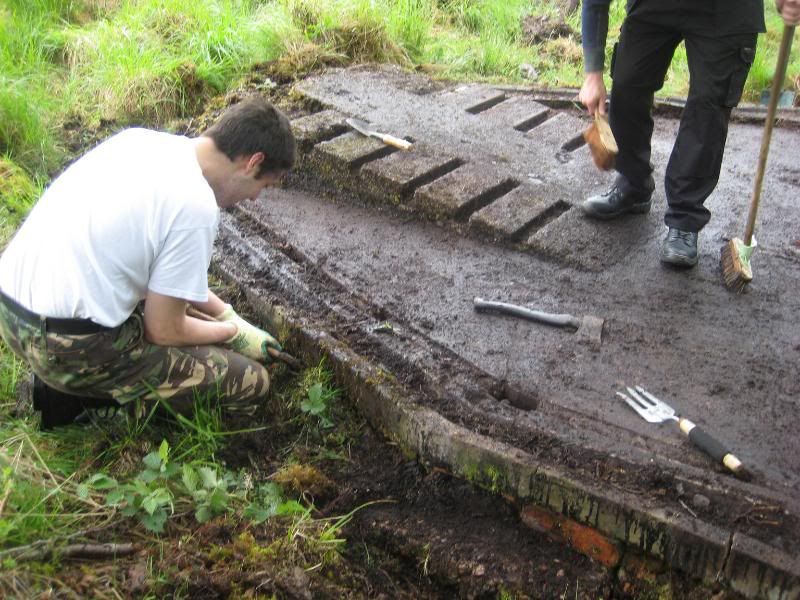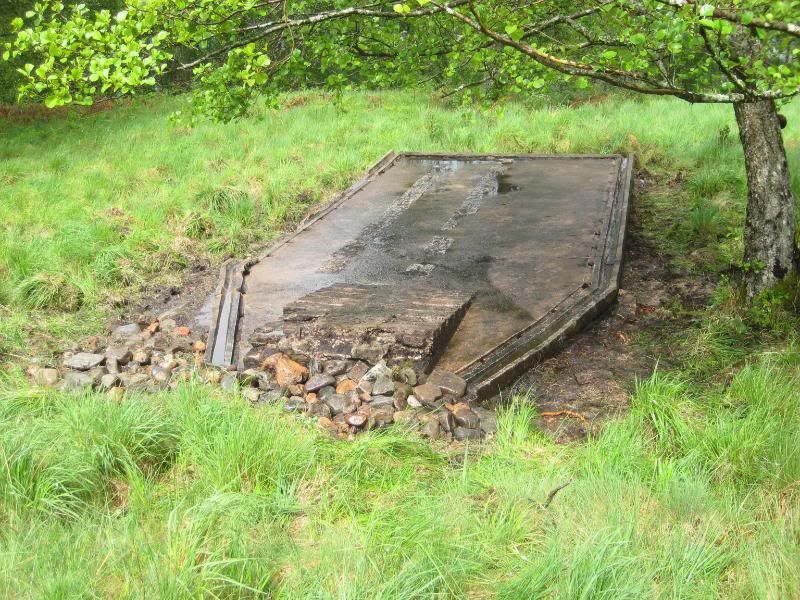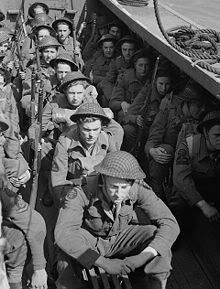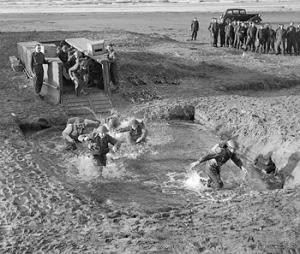| Author |
Message |
|
|
Ebay.com is still a good place for originals. You would need a US mate to buy it for you and ship it over though ;)
I currently make and offer a range of FS knives based on wartime specifications. Free postage/shipping for veteran/serving personnel an all CVA members of course!
http://macdonaldarms.com/armoury/FairbairnSykes.php
|
 |
|
|
The smatchet was carried and used as much by SOE operatives as it was by Cdo's.
A formidable weapon, the weight and balance was such that it handles and moves as an extension of Fairbairn's unarmed combat techniques (strikes exactly as an edge of hand blow)
Paddy Mayne once removed a German's arm with one clean blow of a smatchet!
The British versions are recognisable with 5 small rivets in the grip. US OSS versions usually were constructed with two larger grip rivets.
The Commando smatchet image and weapon specifications can be found on our website page here -
http://macdonaldarms.com/armoury/FairbairnSmatchet.php
|
 |
|
|
B2 marked knives are now confirmed as being manufactured by Wilkinson Sword Co.
|
 |
|
|
Proper job mate! :D
|
 |
|
|
I shall do Belly and thanks for the heads-up!
It would be a pleasure to meet and study the knife John. Do let me know when you are heading North and I'll be happy to meet.
Hopefully we can shed some more collective light on these wee rarities.
|
 |
|
|
A lovely acquisition John!
I have seen images only of a few examples of these types of FS knives before and some are attributed to the legendary John Paisley.
There has indeed been a lot of controversy about Paisley. Some collectors are convinced that his blades were manufactured in the US or Canada in the '70's and sold with the legend of wartime provenance. Here is one main article that attempts to discredit Paisley's authenticity - http://www.usmilitaryknives.com/flook.htm
I have been keen to chase any evidence of Paisley and his knives being authentic. The above article tries to dismiss him largely because the only John Paisley mentioned in wartime Glasgow is a jeweller and not a cutler. The accounts of him originally being a dirk and sgian dubh maker in my mind would confirm this to be the same man, as dirks and sgian dubhs in Scotland have been made according to mid - late C19th Victorian styles since that time, which are not made by cutlers, but by silversmiths or jewellers due to the extensive amount of decorative etching/engraving/chasing and stone-setting on silver grip and scabbard mounts.
Blades are typically either purchased from cutlers or even bought in/imported.
There is also the potential evidence that several JP marked knives have come from the collection of Cpt. Peter Mason. I have attempted to contact Cpt. Mason directly to confirm where and when he may have originally purchased or acquired these but without success to date.
The legend accompanying these knives is that the hollow grip was to accommodate a cyanide pill and they are often referred to as "suicide knives" It would be equally believable and practical for a length of wire for garotting to be carried inside as this was a technique originally taught and there are existing examples of FS knives that have been adapted for having such a wire wrapped around the grip.
I have also been keen to replicate this type of knife but have been reluctant to do so unless further evidence of authenticity can be confirmed.
Congratulations on such a rare find. I would be very keen to have a closer look at this if possible in the near future.
Still on the case of JP and shall keep you updated with any progress.
|
 |
|
|
Very sad news indeed.
Digger was a true inspiration to us and we always enjoyed our rare meetings with him at CVA events. We have been honoured to have known this man.
Our condolences to the family and God Bless you Digger!
|
 |
|
|
A lovely example and well done on your recent purchase.
|
 |
|
|
So sorry Geoff to hear about the loss of your friend Smudger. The man was clearly a legend.
|
 |
|
|
Hi Greg,
I'm Edinburgh based and make 1st and 2nd pattern repros. - http://www.macdonaldarms.com/armoury/FairbairnSykes.php
Feel free to pop into the armoury next time you're in town.
All the Best,
Mac
|
 |
|
|
The BBC have been filming a documentary focusing on Achnacarry and it's part in wartime training.
http://www.bbc.co.uk/news/uk-scotland-highlands-islands-16317515
It screens on BBC2 Scotland 21:00hrs on Tuesday 31st January.
|
 |
|
|
Wonderful news Julie, and well spotted! At the unveiling, we were informed by one of the veterans (Harry Nethersole, 6 Cdo) of the nearby location of concrete bases marking Bren firing points as well as the original rifle range butts.
We are already planning another Achnacarry visit soon to explore these areas and confirm sites of further training equipment remains.
News shall be posted as soon as we hopefully discover more. Looks to be an exciting start to 2012!
|
 |
|
|
Excellent find and many thanks for sharing!
We recently observed from a high quality image of LCA training that the side walls were canvas nailed over the wooden post supports. The Achnacarry LCA is undoubtedly constructed according to these very issued plans. Great research!
|
 |
|
|
Just posted a report of our efforts in the landing craft forum here -
http://www.commandoveterans.org/cdoForum/posts/list/0/2391.page#8425
|
 |
|
|
A few years ago, I had noticed an unusual feature beside the road leading to Achnacarry House. This turned out to be a dry landing craft LCA, originally used for training troop movements on and off craft before embarking on the real thing.
It appeared in a sorry state, largely overgrown and not very noticeable though it was only a very short distance beside the main road. Our living history group is always keen to see new life in wartime equipment and so we embarked upon Operation LCA in order to revive what may be the only remaining piece of training equipment remaining at Achnacarry CBTC.
Heading towards Achnacarry, the structure is located beside the road (right hand side) approximately 500ft before the gates on the left turn-off that lead to the House and Museum.
We first secured permission from Cameron of Lochiel to carry out restoration work and three members of the Commando D Living History Group (Mike, Stephen and myself) and one 4 Para recruit arrived on Saturday 21st May to start work.
Before. With overgrowth and a foreshortened view from the road, shape or function was not so clear.

Detail of a rear section of craft. It's in there somewhere!

"Aye, our work's cut out lads"

Setting about our very own Highland Clearance! Working to clear deck, sides, side channels and post holes.

Starting to take shape.

Working on the bow and ramp section. Here we found evidence of the original lowering door hinges and a large number of rocks to simulate a beach landing.

Rocks unearthed and replaced.

Day 1, job done.

Returning on Sunday to repair some broken guttering sections.

As she now appears.

The craft structure is now very noticeable from the roadside and we can only imagine that surprised locals will now wonder "Who built that there?!"
Two long rows of now broken brick bases on the main deck area were originally built to simulate long benches for seating troops (12 to each bench) A third bench of twelve would also have been on board. With no evidence of this remaining or visible we can assume this may have been mobile such as a PT bench.
Troops seated in LCA.

The concrete base is mounted on a brick foundation and was originally built up with wooden walls, top sections and lowering ramp to simulate the confines of the real thing. We discovered evidence of the original grey paint used for the outer walls, which appeared to have been painted after construction. It is also possible that a water filled ditch was situated directly in front of the exit ramp along with the rocks to simulate a more realistic beach landing.
An original dry LCA in action.

The next stages for this project are to have a short walkway constructed from the road to the craft and the CVA have generously offered to fund a descriptive plaque that should detail the original function and history of this rare piece of Commando history.
Plan is to have all in place by November :D
Our group is indebted to Cameron of Lochiel for allowing us to work on this historic monument, Brian at the Alexandra in Fort William, DF Wishart & Co of Edinburgh for sponsoring tools for the job and of course the CVA for supporting our efforts and furthering commemoration of the Achnacarry LCA. Thankyou All!
|
 |
|
|







